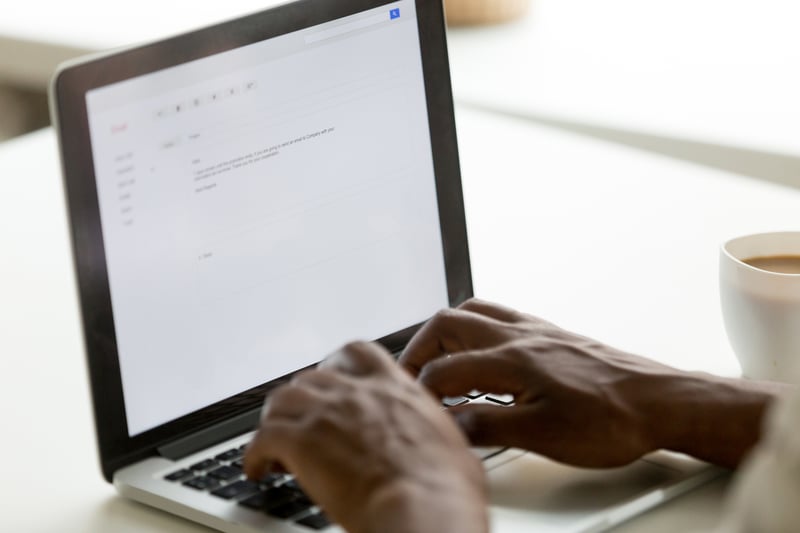Table of Contents
Table of Contents
Cold calls. They might have originally been named because when you make them, the prospect likely hasn't even thought about your business. In marketing, we call that cold.
But these types of calls are cold for a different reason. Like standing outside when it's -30 waiting for the bus, cold calls can absolutely suck.
But it isn't all bad. There are ways to make cold calls easier, like using a cold call script to prepare yourself for each call in advance.
You can also approach cold calling in creative ways, like using a non-standard greeting such as “before you hang up, hear me out” or starting the conversation with a question. The point is, you want the prospect to keep talking.
But let's face it. Winning prospects isn't easy. In fact, it takes around eight touches to make a sale, and you're likely not going to be calling that prospect that many times. Or maybe you will, we're not the cold calling police.
Most salespeople, however, will use a variety of tactics to engage a potential prospect. Yes, cold calling is one of them, but texting, social media, and email open up even more possibilities. Think about it: if a company calls you, then sends you an email a few days later, it somehow seems less annoying than if they called you again.
Also, millennials (yeah, they're all full-fledged adults now) hate answering the phone.
Today, we're going to talk about the art of the cold call follow-up email because it's a very common way to engage a prospect after a call, and yes, it can be successful.
Let's get started.
When to Follow Up After a Cold Call

Great news, there isn't a consensus regarding the best time to send a sales email after you speak to a prospect. Wait, maybe that's not great news.
Anyway.
Some sources say to wait at least 48 hours after a cold call before contacting the prospect again through a follow up cold call email. Others say that it's up to the agent to set a specific time and date that the prospect can expect another call. If they prefer email, then chances are you won't be setting a specific time for that rather just “expect to see this email sometime in the morning or afternoon” is likely to be fine.
But there's no magic formula for ensuring that a prospect will respond to your cold call follow up email. You'll need to use a combination of your own intuition and experience, as well as any social cues from your cold call to determine the best time to send your follow up email.
But experience and intuition are nothing without a game plan. In this case, your cold call follow up email game plan. This is essentially a template or set of guidelines that you can use over and over again to help you figure out the best time to reach out to your prospect.
Here are a few considerations to keep in mind before you reach out to your cold call prospect:
- What you want to say. Ideally, you should have a cold email template ready to go, but you'll still need to tailor the message to your prospect.
- How well the conversation went. If the conversation went well, then you'll likely want to send a follow up cold email as soon as possible. The same day is likely a good bet. This email could include more information about your product or service and maybe a link to a free trial or discount to sweeten the deal. Alternatively, if the conversation didn't go great, but there's still potential, then a simple email with one clear call to action (CTA) is enough. You want to tread lightly and give your prospect room to make a move.
- The time of day. You might be tempted to send a cold call follow up email right away, but hold on to your horses, cowboy. It might not be the best time. If it's near the end of the workday or just about lunchtime, chances are you'll want to send the email at a later time, or even the next day.
Keep in mind that you can make the process of sending out emails easier and faster by using email automation, like drip campaigns. Using the Ringy CRM, you can automatically send emails that welcome new prospects, nurture existing ones, or reach out to prospects that have gone cold (e.g., abandoned cart).
Automatic emails can be personalized as well so that the prospect's name is always used. Alternatively, you can write emails in advance and set them up to be sent to specific prospects at different times.
Cold Call Email Follow Up Sequence
Now it's time to actually write a cold call follow up email that will hopefully turn that prospect into a client. Don't worry, the process is actually pretty straightforward:
Write a Killer Subject Line
Every good story, blog post, and even email should start with an irresistible hook. In this case, the hook is going to be your subject line. The goal with the subject line in your cold call follow up email is to entice your prospect to click. Why? A case study that analyzed over 99,000 sent emails found that 47% of users opened an email based on the subject line alone. That's a huge opportunity that you don't want to miss!
So how do you write a great subject line for your cold email follow up? Here are a few tips:
- Be conversational instead of salesy. If you use the subject line to be pushy or salesy, the prospect is likely to pick up on that and feel a bit off-put. Instead, write with a friendly, conversational tone, and use their name if you can. Personalizing your email can increase open rates and revenue by as much as 760%.
- Be Brief. Email subject lines can get cut off on mobile, so you'll want to keep it short and sweet. Mailchimp suggests that you use no more than nine words and 60 characters.
- Use emojis and special characters sparingly. Using emojis and special characters in your email subject line can help your email stand out in a prospect's inbox, but moderation is key. You don't want your prospect's spam filter to confuse your email for spam and send it to the junk folder, and you don't want to seem unprofessional. Sticking to one or two emojis per email subject line is a good rule of thumb.
Provide Context
Chances are you're not the only salesperson to reach out to your prospect. In addition, there's a good chance that your prospect won't remember you unless your cold call conversation went exceptionally well. That's why it's important to provide context for why you're reaching out, in the subject line if you can, but definitely in the body of your email. Starting out with context in the first few sentences of your email is the best bet.
What's in it for Them
At the end of the day, your prospect wants to know why they should bother doing business with you and whether what you're offering them is even worth their time and energy. Be transparent and clearly outline the benefits of your product or service and how it relates to your prospect's business needs. Bonus points if you do your homework and can provide specific examples. If you do, your prospect will recognize that you've taken the time to research and learn their business, which can go a long way in earning their respect.
Keep it Short and Sweet
Following up after a cold call is crucial to securing a meeting or continuing the conversation. People are busy, so your follow-up email should be concise and informative.
Here's a breakdown of what to include in a short and sweet cold call follow-up email:
Subject Line:
- Grab Attention: The subject line is your first impression in the inbox. Avoid generic greetings like "Following Up" and craft a line that piques their interest. For example, "Addressing Your [Company Pain Point] - As Discussed"
Body of the Email:
- Reintroduce Yourself: Briefly remind the recipient who you are and the company you represent.
- Reference the Call: Mention the date of your call and a key point you discussed.
- Offer Value: Briefly highlight how your product or service can address the needs mentioned in the call.
- Clear Call to Action (CTA): State your desired next step - a meeting, a demo, or a phone call. Make it easy for them to respond with a clear CTA like "Schedule a meeting here: [link to your calendar]."
Here's an example:
Subject: Addressing Your Lead Generation Challenges - As Discussed
Hi [Prospect Name],
This is [Your Name] following up on our call earlier today about [Company Name].
As we discussed, generating qualified leads can be challenging. But we have a solution: our [Product/Service] has helped companies like [Similar Company] increase their leads by [Specific Percentage].
Would you be open to a quick 15-minute call to discuss your specific needs and how we can help? You can schedule a time here: [link to your calendar].
Thanks,
[Your Name]
By keeping your cold call follow-up email concise and valuable, you increase your chances of getting a response and starting a productive conversation.
Don't Forget the CTA
A call to action, or CTA, tells the prospect what they should do next. If your cold call email follow up doesn't guide the prospect forward, then you're involuntary letting the conversation run out of gas.
You'll need to determine what type of CTA works best for your goals, but some examples of CTAs that you can include in a cold call follow up email are:
- A link to a free trial
- A link to a scheduling tool for a follow up meeting, such as Google Calendar
- A link to a product or service landing page where the prospect can make a purchase
- A link to a blog post or downloadable resource
When you're crafting a message for your CTA, make sure that you convey a sense of urgency and use actionable language. Examples of CTA text include:
- Start free trial
- Learn more
- Buy now
- Book a call
How to Follow Up on Cold Email

|
Circumstance |
How to follow up |
|
The prospect didn't respond to your first cold call follow up email |
Send another email out around 2 days later. This can be a modified version of your first email, but the point is to communicate the same message in a different way. |
|
No response to the second cold call follow up email |
Wait 5 days and send another email that's a shorter and more concise version of the first email you sent. It shouldn't be more than a few sentences long. |
|
No response on the third follow up email |
Wait 7-10 days before sending your last email. This is your last-ditch effort, your break-up email, to convince your prospect they have something to lose by not replying. If they don't respond to this email, it's best to move on to greener pastures. |
Knowing When to Send a Follow-Up
Following up on a cold email is an art. You want to strike a balance between persistence and pestering. Here's how to determine the optimal timing for your cold email follow-up:
Initial Follow-Up:
- Generally Wait 2-3 Days: After sending your initial cold email, give the recipient 2-3 business days to respond before considering a follow-up. This allows them time to review your email and potentially discuss it with colleagues.
Factors Affecting Timing:
- Urgency: If your offer is time-sensitive or has a limited window of opportunity, you can justify an earlier follow-up, perhaps within 1-2 days. Clearly communicate the urgency in your subject line.
- Industry Standards: Some industries may have different norms for response times. Research your target audience to understand their communication style.
- Initial Engagement: Did the recipient open your email? Some email platforms offer open-rate tracking. An open increases the chance of a response, so you might follow up sooner (around 2 days) if they opened your email but haven't replied.
Cold Email Follow Up Strategy
Coming up with a good cold email follow up strategy will be essential to your sales success. Sure, you can send emails out willy-nilly to show your boss that you have persistence, but chances are your prospects will just add your email address to their block list.
One strategy on how to send a follow up email after a cold call suggests that you balance persistence with respect to your prospect's time.
This can be done by following several key strategic rules:
|
Cold email follow up rule |
Additional insight |
|
Be persistent but polite |
Resist the urge to rapid-fire emails to your prospect and don't use “you ignored my last email” or other pushy statements. |
|
Ask if it's ok to keep reaching out |
If you've followed up several times but haven't received a response, ask your prospect if you should follow up. It shows respect for their time and yours. |
|
Use your cleverness to stand out |
Finding a unique angle is a great way to connect with your prospect. In the Muse article linked above, the author mentions that they once mentioned in a blog post that they love Pizza. As a result, a salesman contacted them weekly with a pitch and recommendations on new Pizza places to try. It eventually convinced the author to buy. |
The best chance of engaging with your prospect is through the first follow up email to your initial cold call follow up email, or in other words, the second email you send. It's got about a 40% higher open rate ratio when compared to the first email, so it's definitely worth your time to send that follow up to your follow up, if you catch our drift.
As for how many emails you should send out? 2-3 emails sent out at the right frequency (see the previous section of this article on “When to Follow Up After a Cold Call”) seems to be the sweet spot. If your prospect doesn't reply to you by then, chances are they just aren't interested.
10 Best Cold Email Follow up Examples
You may know the fundamentals of how to send a follow up email for a cold call, but examples can help you hone your skills. Let's take a look at some of the best cold email follow up templates that you can rework for your next campaign.
The “I've Done My Research”
Hi [prospect's first name]
After our last conversation, I got excited and wanted to send you a few ideas on how [product or service] can help [prospect's company] today:
[Several bullet point ideas that match features with benefits, using specific examples that relate to the prospect's potential pain points]
There are many more possibilities that I'd love to chat with you about.
What's the best way to get 15 minutes on your calendar?
Thank you, [your name]
The “Follow up Email for Cold Leads”
Hi [prospect's first name]
It's been a while since you've opened our [marketing/communications/sales] emails. We aim to provide you with interesting, relevant, and informative content, but if it's taking up space in your email inbox, we understand if you'd rather not hear from us.
If you want to continue receiving emails from us, you don't have to take any action. But if you don't want to receive these emails anymore, you can unsubscribe by clicking here.
The “Let's Discuss Next Steps Because I Don't Know What They Are”
Hi [prospect's first name]
I'm not sure what the next steps should be from our last conversation. What next steps make sense to you?
Thanks for your input.
[your name].
The “I'm Just Checking in”
Hi [prospect's first name]
When we last chatted, you wanted me to get back to you on [date/time]. I know I'm a bit early, but I wanted to check in with you.
Any thoughts about the proposal I sent? I've attached it to this email as well in case you want to take another look at it.
Let's connect, what time [this week/next week] works for you?
The “Who Should I Contact?”
Hi [prospect's first name]
I didn't hear back from anyone on your team with the last email I sent. If it makes sense to talk, let me know the best time to reach you [this week/next week].
If not, can you please let me know who would be the best person to reach out to?
Thank you for your help,
[your name]
The “OMG, the Prospect Clicked a Link”
Looking for some more information, [prospect's name]?
Here's our latest [blog post/downloadable resource] that gives you an overview of [product or service].
Some key takeaways are:
[list a few bullet points]
If you'd like to learn more about how [product or service] can benefit your company, then let's schedule a chat.
What time would suit you best?
[your name]
The "Social Proof Powerhouse"
Hi [Prospect Name],
Following up on our conversation about [topic]. I noticed that [Company Name], a leader in your industry, recently used [your product/service] to achieve [impressive result].
Could a quick 15-minute call be helpful to explore how [your product/service] can deliver similar results for [Prospect Company]?
Thanks,
[Your Name]
The "Value-Added Resource"
Hi [Prospect Name],
This is to follow up on our conversation about [topic]. As promised, I'm attaching a white paper on [relevant industry trend] that I think you'll find valuable.
It explores [key points] and offers insights that can help companies like yours [achieve specific goal].
Let me know if you have any questions or if you'd like to discuss how [your product/service] can help you implement these strategies.
Thanks,
[Your Name]
The "Addressing a Potential Objection" Follow-Up
Hi [Prospect Name],
I understand from our conversation that budget might be a concern. We offer flexible pricing options to cater to different needs.
Would you be open to a brief call to discuss how we can tailor a solution that fits your budget and achieves your goals?
Thanks,
[Your Name]
The "Humorously Human" (Use with Caution)
Subject: Subject Line Here (Something Catchy and Relevant)
Hi [Prospect Name],
I know you're busy, and my previous email might have gotten lost in the inbox abyss. No worries, consider this my friendly rescue mission!
We discussed [topic] on [date], and I wanted to follow up and see if you have any questions about [your product/service].
If not, that's cool too! Just letting you know there's a human on the other side of this email, not just a robot relentlessly sending messages.
Hope to hear from you soon!
Best,
[Your Name]
With all of these email examples, we're making sure that we include these key points:
- Personalization. Addressing the prospect by their first name starts the conversation off on the right foot and humanizes the connection between yourself and your prospect.
- Providing value. Some emails might just be asking a question, but whenever you can add value to an email naturally by including a resource, blog post, infographic, or other pieces of information, it shows your prospect that you want to give them value in exchange for their time.
- Including a Call to Action. It doesn't necessarily have to be a huge button or a link; a call to action can also be a question or request to keep the conversation going. You want to keep the prospect moving through the sales process and to do that, you have to give them a way to move forward.
Cold Call Follow Up Email Success Stories
A well-crafted cold call follow-up email can turn a lukewarm initial interaction into a hot lead. Here are two success stories that showcase the power of this communication tactic:
1. Success Story 1
Bryan Kreuzberger, the Founder of BreakthroughEmail, was brought in by a consulting agency to assist in closing deals. The agency's pipeline is filled with esteemed Fortune 1000 companies such as Google, AT&T, and Toyota, among others.
Initially faced with a list of 522 companies, the agency encountered a significant challenge: they were struggling to convert leads into sales.
Instead of resorting to generic email templates that often resulted in low response rates, Bryan implemented a series of targeted adjustments to their sales approach.
The results were remarkable: They achieved an impressive 80% email open rate, which translated to additional revenue of $4,386,000. [Source]
2. Success Story 2
Following up after a trigger event, like when a prospect re-opens an email or proposal you sent, is a strategic move in sales. By tracking these events, you gain valuable insights into your prospect's interest and engagement level.
This proactive approach not only helps you better understand your prospect's needs but also increases the chances of converting leads into sales. For instance, a HubSpot customer capitalized on such a trigger event and successfully closed a $100,000 deal. [Source]
Start implementing this strategy today to leverage trigger events effectively and maximize your sales opportunities.
Key Takeaways

It's not easy making cold calls or following up with them. But there are always ways that you can make the process a bit easier.
The key takeaways from this article include:
- The best time to send a follow up email after cold call is at least 48 hours after you make the initial call. This gives your prospect time to digest the information you gave them.
- When planning your cold call follow up email sequence, remember that your subject line should be engaging, the body of the email should provide context for why you're contacting your prospect, and you should mention what's in it for them. Finally, make sure you include a CTA.
- For your cold email follow up strategy, make sure that you're persistent but polite in the emails that you send, and that you use your cleverness to stand out (e.g. incorporating a relevant tidbit of information that you saw on your prospect's social media). Don't be afraid to ask your prospect if it's ok if you keep reaching out to them if you don't get a response after a few messages.
- Use an email template. We've provided six templates that cover most situations but feel free to modify them to fit your sales goals.
If you're looking for a CRM that will drive communication for your sales team, then check out Ringy. Reach out to us today and request a demo, and we'll walk you through our software.

Skyrocket your sales with the CRM that does it all.
Calling? Check. SMS? Check. Automation and AI? Check. Effortlessly keep in touch with your customers and boost your revenue without limits.

Take your sales to new heights with Ringy.
Sales in a slump? Ringy gives you the tools and flexibility you need to capture leads, engage with them, and turn them into customers.
Subscribe to Our Blog
Enter your email to get the latest updates sent straight to your inbox!
Categories
Related Articles





































































































